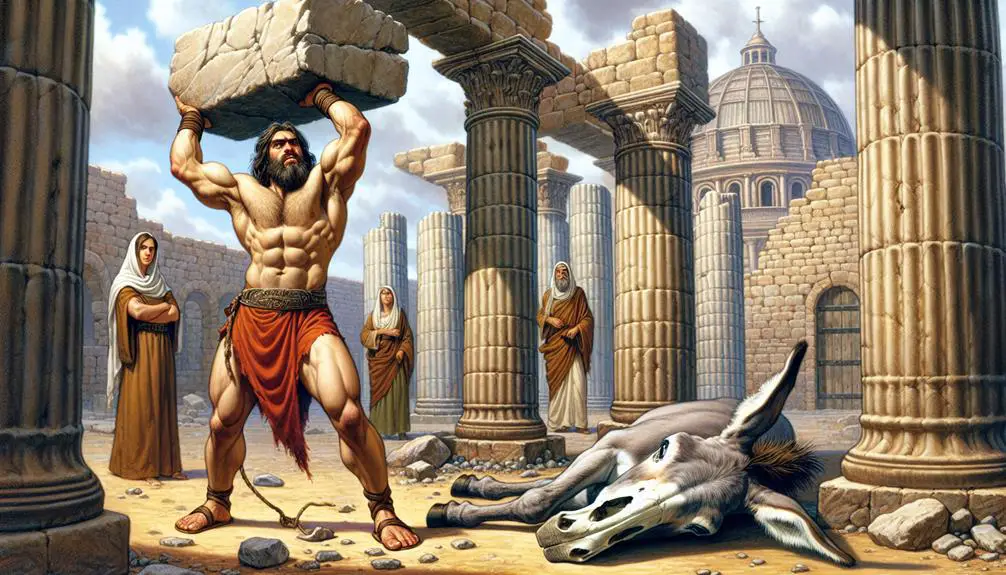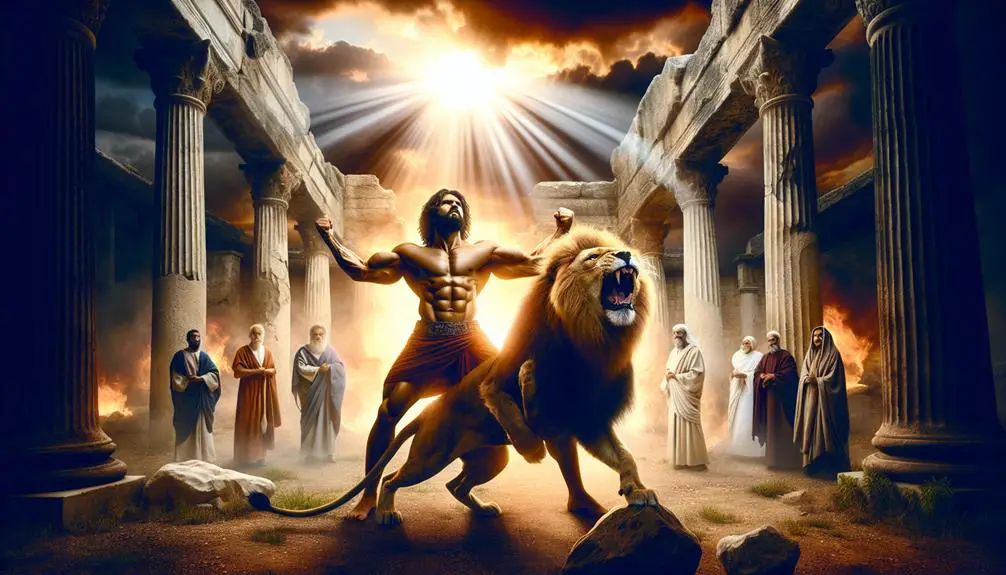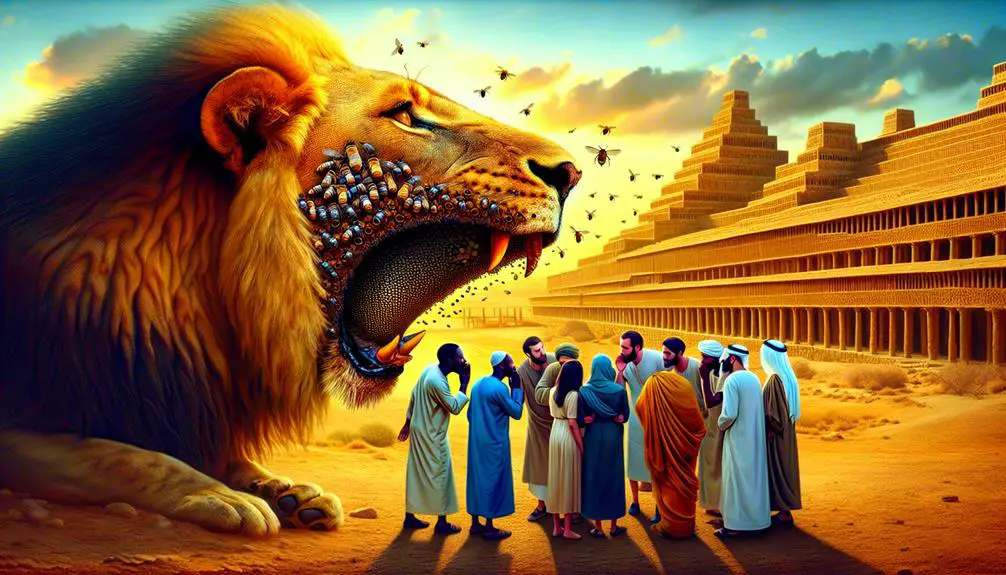Uncover the extraordinary secrets and strength of biblical hero Samson, whose story is far more intriguing than just his legendary locks.

Facts About Samson in the Bible
Samson could probably give modern superheroes a run for their money with his jaw-dropping feats of strength. You've likely heard tales of his exploits, but there's so much more beneath the surface.
From his miraculous birth to the secretive Nazirite vow that fueled his power, each chapter of Samson's life is more fascinating than the last. You're aware of his infamous haircut, but do you know the true significance behind it or what led to his eventual downfall?
Let's embark on a journey to uncover the layers of mystery surrounding one of the Bible's most enigmatic figures.
Key Takeaways
- Samson's birth was prophesied by an angel, marking him for a divine purpose from the start.
- He was bound by the Nazirite vow, which included abstaining from cutting his hair and avoiding corpses.
- Samson's supernatural strength, demonstrated through feats like tearing apart a lion, was a sign of divine empowerment.
- His life ended dramatically by collapsing a Philistine temple, symbolizing divine justice and fulfilling his destiny.
The Miraculous Birth

Samson's birth, foretold by an angel to his previously barren mother, exemplifies a miraculous intervention in human affairs, showcasing divine purpose in biblical narratives. This event, deeply embedded in the fabric of religious texts, underscores the significance of angel visitation as a conduit for divine messaging and intervention. The angel's appearance to Samson's mother, a woman who hadn't been able to conceive, marks a pivotal moment not only in her life but in the unfolding of Israel's history.
The narrative is rich with themes of faith, promise, and the supernatural, yet it doesn't shy away from highlighting parental disbelief. Initially, Samson's mother is incredulous, her reaction mirroring a common human response to the unfathomable or divine. This disbelief serves as a narrative tool, emphasizing the extraordinary nature of the event. It's through overcoming this skepticism that the story conveys a deeper message of faith and the realization of divine promises.
The angel's visitation and the subsequent overcoming of parental disbelief aren't merely plot points but are emblematic of the broader theme of divine intervention in human destinies within biblical literature. This story segment, therefore, is pivotal, setting the stage for Samson's extraordinary life, predicated on a miraculous beginning.
The Nazirite Vow

A pivotal aspect of Samson's story is his adherence to the Nazirite vow, a commitment that profoundly influenced his physical and spiritual journey. This vow, deeply embedded in the religious practices of ancient Israel, set Samson apart, defining his life through stringent rules that governed his actions and appearance. Central to understanding the Nazirite vow are its implications on Samson's life, particularly in terms of dietary restrictions and the significance of hair, which are crucial in appreciating his narrative's complexity.
Key elements of the Nazirite vow impacting Samson include:
- Dietary Restrictions: Samson was prohibited from consuming anything derived from the grapevine, not just alcohol. This restriction symbolized a purity and separation from indulgences and pleasures of the world, underscoring a life dedicated wholly to spiritual pursuits.
- Hair Significance: His uncut hair wasn't merely a personal choice but a physical manifestation of his vow to God. It represented strength, covenant, and a direct link to the divine, serving as a constant reminder of his dedication and separation from ordinary societal norms.
- Avoidance of Corpses: Contact with the dead, which would render him ritually unclean, was strictly forbidden, emphasizing purity and spiritual sanctity above cultural and social engagements.
These components of the Nazirite vow illustrate the profound commitment required and the significant role it played in shaping Samson's destiny, marking him as a distinct figure in biblical history.
Feats of Strength

Throughout his life, Samson displayed remarkable feats of strength that often defy ordinary human capabilities, serving as both a testament to his divine empowerment and a focal point of his narrative within biblical literature. One notable instance is the lion encounter, where Samson, without any weapon, tears a lion apart as if it were a young goat, showcasing not just brute strength but an extraordinary level of physical dominance that could only be attributed to divine intervention. This act isn't merely about physical prowess; it symbolizes his role as an instrument of divine will, capable of overcoming the ferocity of nature itself.
Another significant demonstration of his strength is during the incident at the Gates of Gaza. Samson lifts and carries away the city's gates, along with the two posts and bar, up to a hill facing Hebron. This act wasn't just a display of raw power; it served as a profound statement of defiance against the Philistines, indicating that their attempts to confine or control him were futile. Both events encapsulate Samson's role as a divinely empowered judge, whose physical feats transcended mere human ability, reflecting a deeper narrative of divine empowerment and liberation.
The Riddle and Betrayal

Beyond his unparalleled physical strength, Samson's life was also marked by moments of vulnerability, particularly evident in the episode involving the riddle and his eventual betrayal. At his wedding celebration, Samson proposed a riddle to his Philistine guests, stemming from a personal encounter with a lion, which he'd previously killed. This riddle, seemingly innocuous, set the stage for a series of events that underscored the psychological manipulation and deceit that would lead to his downfall.
The critical elements of this episode include:
- The Challenge: Samson's riddle wasn't just a mere game but a test of wit under the guise of festivity. It highlighted his penchant for intellectual engagement alongside his physical prowess.
- The Betrayal: His bride, coerced by her people, exploited her intimate relationship with Samson to uncover the answer to the riddle. This act of betrayal wasn't just personal but also a reflection of the larger conflict between the Israelites and the Philistines.
- Psychological Manipulation: The Philistines' use of Samson's wife as a tool to manipulate him reveals the strategic psychological warfare employed against Samson, exploiting his emotional vulnerabilities.
This episode, rich in narrative complexity, illustrates how Samson's strengths were matched by his susceptibilities, especially when faced with betrayal and psychological manipulation.
The Final Act

Samson's final act, culminating in the collapse of the Philistine temple, represents the ultimate manifestation of his strength and the tragic culmination of his life's narrative. After being captured and blinded by the Philistines, Samson's story reaches its apex during a public spectacle where he's brought to entertain his captors. In a profound display of Philistine revenge, he calls upon God one last time for strength, not for personal vengeance but as a divine instrument of judgment. Pushing against the temple's pillars, his actions lead to an architectural collapse that kills him along with the Philistine leaders and many others, illustrating the destructive power of unchecked vengeance and the complexities of divine justice.
Aspect |
Analysis |
|---|---|
Motivation |
Driven by a desire for revenge and divine calling |
Outcome |
Architectural collapse, massive loss of life |
Legacy |
A complex hero; his strength and flaws intertwined |
This act is emblematic of the themes of strength, divine intervention, and the cyclical nature of revenge. Samson's life and demise serve as a cautionary tale about the human struggle with power, vengeance, and redemption.
Frequently Asked Questions
How Does Samson's Story Reflect the Societal and Cultural Norms of the Time?
In analyzing Samson's story, you're delving into a narrative deeply rooted in the gender roles and religious rituals of its era. His tale mirrors the societal expectations placed on men and women, showcasing the stark divides in their roles and responsibilities.
Additionally, the emphasis on religious rituals illustrates the central role of faith in guiding societal norms and behaviors. Through this lens, you gain insight into the cultural fabric of the time.
What Are the Historical and Archaeological Evidences Supporting Samson's Existence and the Events Described in His Story?
When examining historical and archaeological evidence for Samson's existence, you'll find scant direct proof.
However, insights into Samson's diet and ancient construction techniques offer tangential support.
For instance, dietary habits hinted at in his narrative align with those of ancient Nazirites, while the construction methods described in events, like the temple's collapse, reflect known engineering practices of the time.
These elements, while not conclusive, add a layer of plausibility to the accounts.
How Has Samson's Character Been Interpreted and Represented in Different Religious Traditions Outside of Christianity and Judaism?
You're diving into a sea of narratives, where Samson's character is reshaped by waves of interpretation.
In the realm of Islamic parallels, his story finds echoes, albeit with nuanced differences that highlight moral and spiritual themes.
Mythological comparisons further enrich this exploration, drawing lines between Samson and figures from diverse traditions.
Analyzing these representations, you uncover a scholarly tapestry, weaving together insights that transcend the boundaries of Christianity and Judaism.
In What Ways Has Samson's Story Influenced Modern Literature, Art, and Popular Culture?
Samson's story has deeply influenced modern literature, art, and popular culture through various adaptations and cultural symbolism. You'll find his narrative reinterpreted in novels, paintings, and films, where his strength and vulnerabilities are explored in new contexts.
These modern adaptations often reflect contemporary values and dilemmas, embedding Samson's tale within a broader cultural symbolism that resonates with themes of power, sacrifice, and redemption. This influence underscores the timeless relevance of his story.
What Psychological Interpretations Have Been Applied to Samson's Actions and Personality Throughout Scholarly Discussions?
You've likely seen scholars apply various psychological interpretations to analyze actions and personalities in historical figures.
Specifically, in discussing a certain character, they've delved into personality archetypes and strength symbolism.
This approach helps to unpack the complex motives and behaviors exhibited, offering a deeper understanding of their actions.
Through this lens, the discussions aim to uncover underlying psychological patterns that could explain seemingly perplexing decisions or traits.
Conclusion
In the tapestry of biblical narratives, Samson's story stands out as a vivid thread woven with paradoxes.
You've observed how his miraculous birth and Nazirite vow set the stage for a life punctuated by Herculean feats, yet marred by human frailties.
Through the lens of his riddle and eventual betrayal, we see the interplay of strength and weakness, loyalty and deception.
In his final act, Samson's story culminates, offering a profound reflection on the dualities of human nature and divine intervention.



Sign up